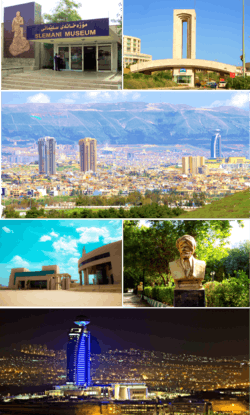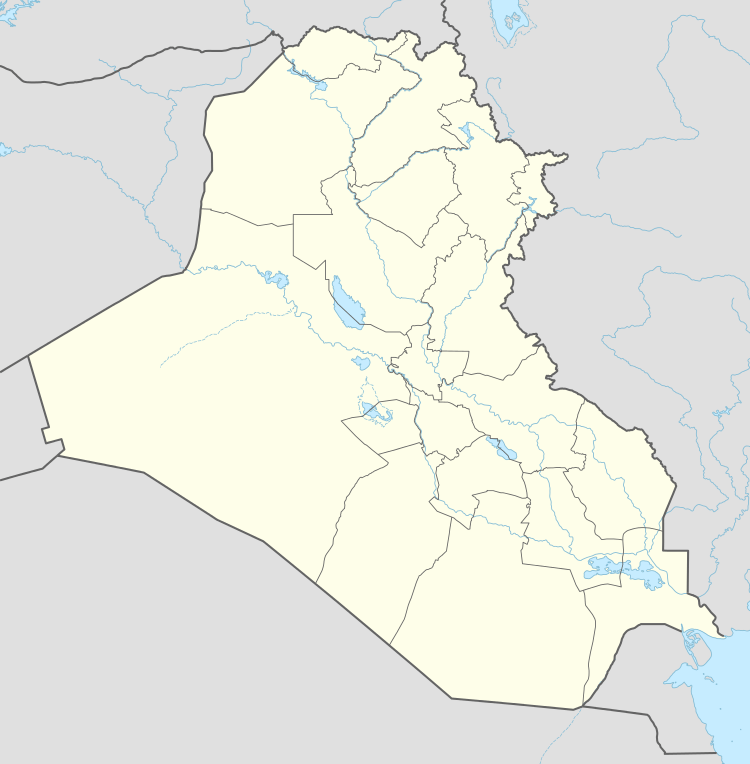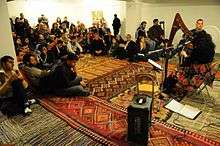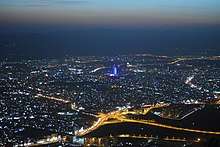Sulaymaniyah
Sulaymaniyah (Kurdish: سلێمانی ,Silêmanî[3][4] Arabic: السليمانية, as-Sulaymāniyyah), also called Slemani, is a city in the east of the Kurdistan Region, Iraq, not far from the Iran-Iraq border. It is surrounded by the Azmer Range, Goyija Range and the Qaiwan Range in the northeast, Baranan Mountain in the south and the Tasluja Hills in the west. The city has a semi-arid climate with very hot dry summers and cool wet winters.
Slemani سلێمانی | |
|---|---|
 Sulaymaniyah city montage | |
 Slemani  Slemani | |
| Coordinates: 35°33′26″N 45°26′08″E | |
| Country | |
| Region | |
| Governorate | Sulaymaniyah Governorate |
| Government | |
| • Type | Council–manager |
| • Governor | Haval Abubakir[1] |
| Elevation | 882 m (2,895 ft) |
| Population (2016) | |
| • Total | 800,000[2] |
| Time zone | UTC+3 (UTC+3) |
| • Summer (DST) | not observed |
| Website | http://www.sharawani.com |
From its foundation Sulaymaniyah was always a center of great poets, writers, historians, politicians, scholars and singers, such as Nalî, Mahwi, and Piramerd.[5][6][7] The modern city of Sulaymaniyah was founded in 1784 by the Kurdish prince Ibrahim Pasha Baban, who named it after his father Sulaiman Pasha.[8] Sulaymaniyah was the capital of the historic principality of Baban from 1784 to 1850.
History

The region of Sulaymaniyah was known as Zamwa prior to the foundation of the modern city in 1784. The capital of the Kurdish Baban principality (1649–1850), before Sulaymaniyah, was a territory named "Qelaçiwalan". At the time of the Babani's rule there were major conflicts between the Safavid dynasty and the Ottoman Empire. Qelaçiwalan became a battleground for the two rivals.[9]
Being of strategic importance and lying deep inside Safavid territory, there was concern that Qelaçiwalan would be attacked and captured if the Babani did not give the Safavids military support, as both Sultan Mahmud II and Nader Shah were trying to gain the support of the dispersed Kurdish Emirates.[9] This obliged Mahmud Pasha of Baban in 1781 to think about moving the center of its Emirate to another safer place. He chose Melkendî, then a village but now a district in central Sulaymaniyah, to construct a number of Serahs for his political and armed units.[9]
In 1783, Ibrahim Pasha Baban became ruler of the Emirate and began the construction of a new city which would become the capital of the Baban Emirate. In 1784 he finished erecting a number of palaces for trade called Qeyserîs and bazaars, which were also used as baths, and began inviting people from the surrounding villages and Emirates to move to the newly established city. Soon Melkendî, which was originally intended to be the city itself, instead became one of its quarters and still is today.[9] The new city of Sulaymaniyah was named after Sulaiman Baba, who was the first Baban prince to gain control of the province of Şarezûr and its capital, Kirkuk. Sulaiman Baba invaded the neighboring Kurdish vassaldom of Erdalan, defeating their forces in 1694. Ottoman Sultan Mustafa II assigned him the district of Baban, which included the town of Kirkuk.[10]
In the early 1800s refugees from Ardalan moved to Sulaymaniyah including Mastura Ardalan, the widow of Xosraw Xanî Erdalan, the ruler of the kingdom. Erdalan wrote an account of Kurdish history in Persian and was buried in Sulaymaniyah when he died in 1848.[11]
From 1922 to 1924, Sulaymaniyah has designated the capital of the Kingdom of Kurdistan, a short-lived unrecognized State declared by Iraqi Kurds following the collapse of the Ottoman Empire.[12]
Demographics
In 1820, only 26 years after the creation of the city, a British man named Rech visited the city and estimated that its population was more than ten thousand, containing 2,144 families of which 2,000 were Muslim, 130 Jewish, and 14 Christian.[13]
Ottoman documents from 1907 suggest that there were 8,702 Muslim and 360 non-Muslim residents living in the city at that time.
The Peshkawtin newspaper which was distributed in Sulaymaniyah in 1920 estimated its population to be around ten thousand.
According to Iraqi government documents, by 1947 the number of residents had increased to 23,475; by 1998 to 548,747, and in 2015 to an estimated 656,100.[14] The American University of Iraq, Sulaimani estimated the number of inhabitants in 2016 at 800,000 [15]
Geography and climate
The city is located in northern Iraq. Of the main population centers in the country, it is characterized by its cooler summer temperatures and its rainier winters. Average temperatures range from 0 to 39 °C (32–102 °F). In the winters, there can be a significant amount of snow.
Snow is not frequent in winter, but snow has fallen in Sulaymaniyah in also it has fallen every year since then. January 2008,[16] January 2010,[17] March 2012,[18] January 2013,[19] and January 2015.[20]
Köppen-Geiger climate classification system classifies its climate as hot-summer Mediterranean climate (Csa).[21]
| Climate data for Sulaymaniyah | |||||||||||||
|---|---|---|---|---|---|---|---|---|---|---|---|---|---|
| Month | Jan | Feb | Mar | Apr | May | Jun | Jul | Aug | Sep | Oct | Nov | Dec | Year |
| Average high °C (°F) | 7.8 (46.0) |
10.3 (50.5) |
15.5 (59.9) |
20.8 (69.4) |
28.4 (83.1) |
35.0 (95.0) |
38.8 (101.8) |
38.8 (101.8) |
34.7 (94.5) |
28.2 (82.8) |
18.7 (65.7) |
11.1 (52.0) |
24.0 (75.2) |
| Daily mean °C (°F) | 3.8 (38.8) |
5.6 (42.1) |
10.4 (50.7) |
15.2 (59.4) |
21.4 (70.5) |
27.6 (81.7) |
31.3 (88.3) |
31.4 (88.5) |
27.2 (81.0) |
21.1 (70.0) |
13.1 (55.6) |
6.7 (44.1) |
17.9 (64.2) |
| Average low °C (°F) | −0.2 (31.6) |
1.0 (33.8) |
5.3 (41.5) |
9.7 (49.5) |
14.5 (58.1) |
20.3 (68.5) |
23.9 (75.0) |
24.1 (75.4) |
19.7 (67.5) |
14.1 (57.4) |
7.6 (45.7) |
2.3 (36.1) |
11.9 (53.3) |
| Average precipitation mm (inches) | 129 (5.1) |
146 (5.7) |
132 (5.2) |
100 (3.9) |
41 (1.6) |
0 (0) |
0 (0) |
0 (0) |
0 (0) |
13 (0.5) |
74 (2.9) |
110 (4.3) |
745 (29.2) |
| Source: Climate-Data.org (altitude: 849m)[21] | |||||||||||||
Education
Public education is free from primary school until graduation from university. The University of Sulaymaniyah was opened in 1968 with instruction in Kurdish, Arabic, and English. It has faculties in engineering, agriculture, the arts, science, and medicine. It is the largest university in Kurdistan Region of Iraq.
A new University of Sulaymaniyah[22] was established in 1991, teaching in Kurdish, English and Arabic. A second, new university is Sulaimani Polytechnic University[23] was established in 2012, teaching in Kurdish, English and Arabic.
Qaiwan International University (QIU) was established in Sulaymaniyah City in 2018. This university is franchised by Universiti Teknologi Malaysia (UTM) to run several academic programmes. Students who enroll for academic studies at QIU will get degrees awarded by UTM. They will be studying the same academic programmes designed by UTM. QIU courses are taught by international academic staff of which most are UTM lecturers. Students will have the chance to study one or two semesters in Malaysia during their studies
In 2007 The American University of Iraq – Sulaimani,[24] (AUI-S) was a new addition to the American universities in the Middle East, graduating its fifth class in 2016. Instruction at this private, not-for-profit liberal arts university is in English only, featuring a US-accredited program in English as a Second Language (ESL).
The Komar University of Science and Technology,[25] (KUST) – Sulaymaniyah was established and licensed by the Ministry of High Education and Scientific Research in Kurdistan Region Government, by the official letter no. 17867/7 on 18 October 2009. KUST is a private university governed by a Board of Trustees and run by an Administration Council. Its main campus is located in Sulaymaniyah. KUST offered its first teaching classes in 2010 with an English language summer course (levels 1 and 3).[26]
The University of Human Development is another highly reputed university in Sulaymanyah. University of Human Development (UHD) is a non-profit private university founded by Professor Dr. Ali Muhealdin Qaradaghi in 2008, and officially opened by Official Order No. 19211/3 on 16 December 2008 issued by the Ministry of Higher Education and Scientific Research, Kurdistan Regional Government. University of Human Development is a national university licensed by Iraqi Ministry of Higher Education and Scientific Research according to Ministerial Order No. 6613 dated 24 September 2017.
Culture

The two independent newspapers Hawlati[27] and Awena[28] and the two independent political magazines Lvin and Shock, are published and distributed in Sulaymaniyah city.
Sulaymaniyah is the only city in South Kurdistan that regularly celebrates World Music Day or Fête de la Musique. In one trip to the city, a journalist working for the BBC wrote about Sulaymaniyah's distinct culture: "Culture is hugely important to the Kurdish people, especially in Sulaymaniyah, but there is a strong pull to the west—modernisation and consumerism—driven perhaps by the satellite televisions they have had access to since they started running their own affairs...And at the university, students mill around the campus, chattering with each other and doing some last-minute cramming for their exams. The war only stopped lectures for a few weeks. There are probably more women than men and they are happy to air their views to anyone who asks."[29]
Economy
Since 2003 Iraq has seen a huge economic boom. Sulaymaniyah's economy today relies on tourism, agriculture[30] and a number of small factories, most of which are involved in the building trade.
In 2004 the Comprehensive Food Security and Vulnerability Analysis in Iraq released an in-depth survey of the Sulaymaniyah Governorate in which they surveyed each city. In this survey, one can see the economic boom of 2003 mentioned earlier.[31]
Tourism
.jpg)


The city was visited by more than 60,000 tourists in 2009.[32] Sulaymaniyah attracted more than 15,000 Iranian tourists in the first quarter of 2010, many drawn by the fact it is not subject to strict laws faced at home. Newroz 2010 drew an exodus of Iranian tourists choosing to celebrate the event in the region.[33]
- Sulaimani Museum: It is the second biggest museum after the national museum in Baghdad. It is home to many Kurdish and ancient Persian artifacts dating back to 1792–1750 BC.[34]
People from Sulaymaniyah
- Khâlid-i Baghdâdî (1779–1827), sufist and Islamic thinker
- Salim (1800–1866), poet.
- Nalî (1800–1873), poet.
- Mahwi (1830–1906), poet.
- Said Pasha Kurd, (1834–1907), Ottoman statesman.
- Mustafa Zihni Pasha (1838–1911), Ottoman official, Kurdish nationalist.
- Saeb (1854–1910), poet.
- Şerif Pasha, (1865–1951), Ottoman diplomat, ambassador and statesman.
- Mustafa Yamulki (1866–1936), Minister of Education in the Kingdom of Kurdistan.
- Haji Mala Saeed Kirkukli Zada (1866–1937), Minister of Justice in the Kingdom of Kurdistan.
- Piramerd Tawfeq Mahmoud Hamza, (1867–1950), poet and journalist.
- Muhamed Amin Zaki (1880–1948), historian, statesman and politician.
- Mufti Penjweni (1881–1952), poet.
- Taufiq Wahby (1891–1984), linguist, politician and poet.
- Sheikh Nuri Sheikh Salih Sheikh Ghani Barzinji (1896–1958), journalist and poet.
- Najmadeen Mala (1898–1962), writer, journalist and teacher
- Ahmad Mukhtar Baban (1900–1976), prime Minister of Iraq 1958.
- Abdulla Goran (1904–1962), founder of modern Kurdish poetry
- Ibrahim Ahmad (1914–2000), novelist, poet and translator.
- Jamal Nebez (born 1933), linguist.
- Nawshirwan Mustafa (1944–2017), politician, historian and media proprietor.[35]
- Ahmad Hardi (1922–2006), poet.
- Sherko Bekas (1940–2013), contemporary poet.
- Bachtyar Ali (born 1960), novelist
- Mariwan Kanie (born 1966), intellectual.
- Barham Salih (born 1960) politician.
- Muhamad Salih Dilan (1927–1990), musician and poet.
- Shahab Sheikh Nuri (1932–1976), politician.
- Dilshad Meriwani, (1947–1989), actor, poet, writer and journalist.
- Rizgar Mohammed Amin (born 1958), judge.
- Mahmoud Othman (born 1938), politician.
- Xalîd Reşîd (born 1968), musician
- Taha Baban, author, actor and lawyer
- Adnan Karim, (born 1953), artist
- Shwan Kamal, (born 1967), artist and sculptor.
- Sara Omar, (born 1986), author, human rights activist and poet.
Politics
In recent years, many people in Sulaymaniyah have distanced themselves from Kurdish nationalism as the Kurdistan Workers Party is experiencing a surge.[36]
Diplomatic missions
- Islamic Republic of Iran, Girdi Consulkhana
Twin towns – sister cities
See also
- 2011 Kurdish protests in Iraq
- Chaldean Catholic Archeparchy of Kirkuk-Sulaimaniya (former Eastern Catholic diocese)
- Dohuk Governorate
- Duhok
- Erbil
- Erbil Governorate
- Ranya
- Sulaymaniyah Governorate
References
- "Sulaimani Polytechnic University". spu.edu.iq. 13 June 2015. Retrieved 13 June 2015.
- "Life in Sulaimani". The American University of Iraq Sulaimani.
- "Bi wêneyên Pêşengeha Pirtûkan a Navnetewî ya Silêmanî". Rûdaw. 23 November 2019. Retrieved 18 December 2019.
- "سەرۆکی هەرێمی کوردستان سەردانی سلێمانی دەکات". Rûdaw (in Kurdish). 25 November 2019. Retrieved 18 December 2019.
- Salih Rasha, Akram. Sulaymaniyah 200 Years. Sulaymaniyah, Kurdistan. pp. 503–504.
- slimany
- Is the Paris of Iraq (21 September 2016). "Sulaimani city, on verge of economic collapse?". Kurd Net – Ekurd.net Daily News.
- Ali, Meer Ako. "Sulaimany: 227 years of glory". The Kurdistan Tribune.
- "The Leading Suly Government Site on the Net". sulygov.com. Retrieved 9 August 2012.
- Gábor Ágoston, Bruce Alan Masters (2009), Encyclopedia of the Ottoman Empire, p.70, Infobase Publishing, ISBN 9781438110257
- Goudsouzian, Tanya (21 November 2016). "Sulaimania: Saving the dream city of a Kurdish prince". aljazeera.com. Al-Jazeera. Retrieved 21 November 2016.
- Prince, J. (1993), "A Kurdish State in Iraq" in Current History, January.
- ckb:سلێمانی
- "Iraq: Governorates, Major Cities & Urban Centers – Population Statistics, Maps, Charts, Weather and Web Information". www.citypopulation.de.
- "Life in Sulaimani". The American University of Iraq Sulaimani.
- "Iraq under cold front bringing snow with below zero temperatures". Indian Muslims. Kuwait News Agency (KUNA). 11–12 January 2008. Archived from the original on 28 September 2013. Retrieved 3 March 2013.
BAGHDAD, Jan 11 (KUNA) – snow fell on large areas of Iraq following two days of low temperatures.
- "Snow covers Sulaimaniya". National Iraqi News Agency (NINA). 26 January 2010. Archived from the original on 26 February 2014. Retrieved 3 March 2013.
Sulaimaniya (NINA) –The city of Sulaimaniya witnessed a heavy fall of snow that covered the entire city since Monday midnight. Reporter of the National Iraqi News Agency said “The citizens of Sulaimaniya woke up on Tuesday morning to see their city covered with snow and the street painted in white color.”
- "Heavy Snow Blankets Sulaimaniya". Iraq Updates. 3 March 2012. Retrieved 3 March 2013.
- "Unusually heavy snow hits Iraq's Sulaimaniya". Al Arabiya. Reuters. 14 January 2013. Retrieved 3 March 2013.
An unusually heavy snowstorm blanketed Sulaimaniya city, in northern Iraq’s autonomous Kurdish region, on Saturday (January 12) as severe weather conditions continue to sweep through the region.
- "11 Refugee Children Freeze to Death in Kurdistan Camps". Erbil. 12 January 2015. Archived from the original on 3 February 2015. Retrieved 3 February 2015.
- "Climate: Sulaymaniyah – Climate graph, Temperature graph, Climate table". Climate-Data.org. Retrieved 4 January 2014.
- "University of Sulaimani". Univsul.org. Retrieved 9 August 2012.
- "Sulaimani Polytechnic University". spu.edu.iq. Retrieved 24 October 2014.
- auis.org Archived 23 November 2010 at the Wayback Machine
- "KUST – Komar University of Science and Technology". KUST – Komar University of Science and Technology.
- "Komar University of Science and Technology". Archived from the original on 3 June 2011. Retrieved 8 August 2012.
- "Hawlati.info". Hawlati.info. Retrieved 26 August 2014.
- "ئاوێنە نیوز". Awene.com. Retrieved 26 August 2014.
- "Kurdistan diary: Day Three". KurdishGlobe. 28 October 2006. Archived from the original on 10 March 2012. Retrieved 9 August 2012.
- "Slemani". Investpromo.gov.iq. Retrieved 9 August 2012.
- "Comprehensive Food Security and Vulnerability Analysis in Iraq" (PDF). Archived from the original on 14 August 2011. Retrieved 12 April 2011.CS1 maint: BOT: original-url status unknown (link)
- "Rudaw.NL, dé Opinieblog…". Rudaw.nl. Retrieved 9 August 2012.
- "Rudaw.NL, dé Opinieblog…". Rudaw.nl. Retrieved 9 August 2012.
- "Suleimaniya Museum: a small place for a great civilization". KurdishGlobe. 13 February 2008. Archived from the original on 8 March 2012. Retrieved 9 August 2012.
- "Wusha Corporation". Wusha.net. Archived from the original on 14 June 2012. Retrieved 9 August 2012.
- "Kurdish Nationalism at an Impasse". The Century Foundation. tcf.org. 29 April 2019. Retrieved 18 April 2020.
- "Tucson Sister Cities". Interactive City Directory. Sister Cities International. Archived from the original on 4 October 2013. Retrieved 4 September 2013.
- اعلام خواهرخواندگی سلیمانیه عراق و ناپل ایتالیا Archived 5 October 2013 at the Wayback Machine, Kurdpress (Persian), 30 April 2013.

.jpg)